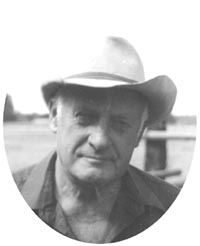a weblog sharing info on outdoor skills and campfire musing by a guy who spends a bunch of time in pursuit of both
CULTURE
WHERE -
TALES ARE TOLD OF
Welcome to Roland Cheek's Weblog
Roland is a gifted writer with a knack for clarifying reality. Looking forward to more of his wisdom
- Carl Hanner e-mail
It is because the vast majority of people do not have the courage to venture off the beaten path that they fail to find adventure, and live lop-sided lives. A good healthy curiosity is better equipment to venture forth than any amount of learning or education. The beaten paths of conformity are literally a prison.
To access Roland's weblog and column archives
Tip o' the Day
There've been dozens of near-unbelievable stories about journeys of domestic animals traveling enormous distances to return to familiar surroundings or explore new ones. So why not wild creatures? Listen to these incredible journeys:
EARL THE ELK - Trapped and radio-collared as a spike bull in the Sweetgrass Hills of northern Montana during late February, 1987. Disappeared from radio survey area within 30 days. Not sighted again until mid-spring of 1990 when reports popped up in northwestern Missouri of a "big mule with horns and wearing a white collar."
Struck by two automobiles while crossing highway. One woman hospitalized. Reported white-collared animal dragged himself from road. Disappeared for two months, then moved into Kansas City suburb. Attracted crowds wherever he went. Authorities decided to trap and remove the animal for public safety. Darted on football field at dawn. Collar itentified him as Sweetgrass elk. Collar returned to Montana, but Earl stayed in Missouri, in a wildlife exclosure just outside Kansas City. [Earl's story is detailed in Roland's book, The Phantom Ghost of Harriet Lou]
GRIZZLY ESCAPE ARTIST -We know exactly how the young female grizzly traveled to southwestern Oregon -- she went there by truck, transported against her will after being judged incorrigibly addicted to breaking and entering camps and foodstocks near a remote wilderness portal. Trapped once and given a second chance, she was released on Ear Mountain, near Choteau. Within days, she'd torn off her radio and crossed the Continental Divide to the scene of her earlier crimes. Trapped again, she was sent to the Oregon wildlife farm.Within months the escape artist was free, having squeezed trough a ridiculously tiny gap in a fence that was seven feet from the ground. Subsequent efforts to locate the bear was futile . . . until she bumped up against Oregon black bear hunters and took umbrage at their bear hounds. [Story in detail in Learning To Talk Bear]
TRAVELING WOLF - Then there's the tale about the wolf who originated from a pack that came down from Canada, then didn't stop until he wound up in Wyoming, south of Yellowstone National Park -- before wolves were transplanted there! What prompted the Teton wolf's incredible journey? If you find out, there's a bunch of folks who'd like to know.
HITCHHIKING SALMON - As incredible as the previous journeys seem, nothing matches that of Idaho Salmon smolts on their way to the ocean. In order to avoid being sucked into the plethora of turbines in the Columbia River dams, the young salmon fry are sucked into trucks and transported around the dams.
Somehow juvenile salmon traveling down our highways, instead of down our rivers, seen the most incredible of all.
I have just finished The Phantom Ghost of Harriet Lou. Wow! It was wonderful! I was transported from my stateroom aboard a destroyer to the wilderness I roamed as a teenager. Your tales were well told, enlightening and dead on the money. The open ocean on a calm clear night is beautiful, but I'll never hear the hoarse bellow of a rutting bull. Driving a warship from the bridge into heavy seas and tailing green water is exhulting, but not nearly as much as stumbling across grizzly tracks that haven't begun to fill in. Thank you for sharing with me. My dad sent me the Thursday Great Falls Tribune, no matter where I am in the world for the last 13 years. I have always enjoyed your writing, but this book was special.
LISTENING FOR SPIRITS
Okay, I'll confess to being a skeptic when it comes to the supernatural. Perhaps it's a touchy-feely thing -- if I can't see it or hear it or smell it or taste it or feel it, my logical side says it ain't there. However, simple disbelief is not sufficient to prevent me from attempting to communicate with spirits from the nether world.
The most recent occasion was in the spring just past, while Jane and I were hiking in the Canyonlands of southeastern Utah. It's stark country, appearing as if it sat in a celestial oven far too long: deep, erratic gashes where the dough cracked and split; giant blisters called mesas or buttes, where God ran a scraper across the top to make them fit beneath the sky. It's a land that comes in many shades of brown, with a few tinges of orange. It's silent, unforgiving. Everything living there bites, stings, scratches, claws, or pokes. Water is in short supply.
An ancient people dwelled amid those remote canyons, but they're gone now, disappearing into a mysterious desert antiquity as surely as dinosaurs vanished during the Jurassic. For want of a word of their choice, we call those absent people Anasazi. And we marvel at a bewildering array of cultural evidence they left behind: cliff dwellings, pottery, stone mortars and pestles for grinding corn, hand carved toe-holds up steep cliffs we call "Moki steps."
Why did the Anasazi abandon their homeland? Archeologists submit several theories: climate change, invading "other" peoples, overharvesting of the land's flora and fauna. Yet archeology awaits a definitive answer. When we first began visiting the Canyonlands, consensus held the Anasazi to be a basically gentle people, dwelling in small "family" groups. But that picture seems to be crumbling as more and more evidence surfaces that violence played a role in Anasazi life (and death).
From a layman's view, I'm tending more and more to think less and less that these ancient people were as splintered into small groups as we've been led to believe. My first reason for doing so occurred when we visited a fabulous defensive site.
Where it narrows, the rock spine you see pictured above is roughly 15 feet wide and 200 yards long. The cliffs fall either side for 500 feet. The knob at its end houses a ruin that could shelter perhaps fifty people. In my view, 20 warriors could hold the spine against an army. Yet inhabitants could not grow foodstuff on the spine. In short, the position was a fall-back one to be used during an enemy invasion. It was for defense, pure and simple.
My second reason for believing the Anasazi inhabitants of this land gathered in larger bands than mere family groups was an offensive one: A grave was discovered near an obscure ruin in a remote canyon that contained 96 skeletons, most of which show clear evidence that the peoples were massacred, possibly with most of them perishing at the same time.
Isn't it logical to assume some organization existed in a culture who designed a defensive position such as the one pictured above, and developed sufficient offensive capabilities to massacre nearly a 100 people in one fell swoop? But how? What kind of organization? When were they so organized? I'm told the gravesite's bodies date back at least 1,300 years, whereas the defensive position might have been constructed 500 years later.
It's a conundrum that I pondered as I sat atop limestone rock gazing down into the remnant ruin where the grave was discovered. The canyon was narrow and short, leading from a larger canyon housing other ruins and a much more lush valley bottom. Moki steps led from the ruin where the victims were either trapped, or led to their death. Which was it? No matter; it would've taken a very large enemy party of terrifying warriors to do either.
A gusting wind rippled my windbreaker as I slipped into it. A sun peaked from speeding clouds long enough to spit a few drops of rain, then rushed into hiding again. I shivered and shifted while waiting for the spirits to speak, to tell what is not yet apparent to better trained (but no less curious) researchers than me.
There was only the wind.
Roland Cheek wrote a syndicated outdoors column (Wild Trails and Tall Tales) for 21 years. The column was carried in 17 daily and weekly newspapers in two states. In addition, he scripted and broadcast a daily radio show (Trails to Outdoor Adventure) that aired on 75 stations from the Atlantic seaboard to the Pacific Ocean. He's also written upwards of 200 magazine articles and 12 fiction and nonfiction books. For more on Roland, visit:
www.rolandcheek.com
Recent Weblogs
Tuesday, June 5, 2007
There's a bunch of specific info about Roland's books, columns, radio programs and archives. By clicking on the button to the left, one can see Roland's synopsis of each book, read reviews, and even access the first chapter of each of his titles. With Roland's books, there's no reason to buy a "pig in a poke."
for detailed info about each of Roland's books
Read Reviews
Read their first chapters
For interested educators, this weblog is especially applicable for use in history, science, and environmental classes, as well as for journalism students.
Roland, of course, visits schools. For more information on his program alternatives, go to:
NEXT WEEK:
ABOUT SILK AND GUNPOWDER
www.campfireculture.com
source links for additional info
to send this weblog to a friend
to tell Roland what you think of his Campfire Culture weblog
to visit Roland's newspaper columns and weblog archives
- Aldo Leopold
Marcus Cheek Photo
Just finished Dance On the Wild Side. It is a wonderful!!! book. Was unable to put it down until I finished it. Want a harcover Bob Marshall book
In the wonderful, descriptive way Cheek aficionados have come to expect, he brings the bears and other wilderness denizens to life in the reader's imagination. The book is not a documentary. Neither is it a novel. Cheek has simply filled in the blanks with plausible storylines. The animals and events he describes arise from knowledge gained during a life in the mountains observing nature in general, but with concentration on elk and bears.
- Rural Montana
A friend recently loaned me a book to read, saying, "You and this man have a lot in common, and I think you will enjoy this book very much." I told her that I was already reading two books, and that it might be quite a while before I could get yours back to her. That evening I picked up your book My Best Work is Done at the Office, and I was reading it until 2:00 in the morning. I haven't touched my other books since! I just finished this and am about to start Chocolate Legs. My other books can wait. - H. Robert Krear / Estes Park, CO
- Frank Morgan / Willamina, OR
Roland's best selling book, in its 5th printing









